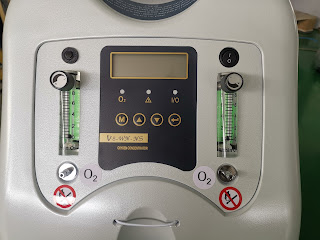PSA oxygen concentrator
Oxygen concentrators typically use pressure swing adsorption (PSA) technology and are used very widely for oxygen provision in healthcare applications, especially where liquid or pressurized oxygen is too dangerous or inconvenient, such as in homes or in portable clinics. For other purposes there are also concentrators based on membrane technology.
An oxygen concentrator takes in air and removes nitrogen from it, leaving an oxygen enriched gas for use by people requiring medical oxygen due to low oxygen levels in their blood.Oxygen concentrators are also used to provide an economical source of oxygen in industrial processes, where they are also known as oxygen gas generators or oxygen generation plants. Oxygen concentrators utilize a molecular sieve to adsorb gases and operate on the principle of rapid pressure swing adsorption of atmospheric nitrogen onto zeolite minerals and then venting the nitrogen. This type of adsorption system is therefore functionally a nitrogen scrubber leaving the other atmospheric gases to pass through. This leaves oxygen as the primary gas remaining. PSA technology is a reliable and economical technique for small to mid-scale oxygen generation, with cryogenic separation more suitable at higher volumes and external delivery generally more suitable for small volumes.
At high pressure, the porous zeolite adsorbs large quantities of nitrogen, due to its large surface area and chemical character. After the oxygen and other free components are collected the pressure drops which allows nitrogen to desorb.
An oxygen concentrator has an air compressor, two cylinders filled with zeolite pellets, a pressure equalizing reservoir, and some valves and tubes. In the first half-cycle the first cylinder receives air from the compressor, which lasts about 3 seconds. During that time the pressure in the first cylinder rises from atmospheric to about 2.5 times normal atmospheric pressure (typically 20 psi/138 kPa gauge, or 2.36 atmospheres absolute) and the zeolite becomes saturated with nitrogen. As the first cylinder reaches near pure oxygen (there are small amounts of argon, CO2, water vapour, radon and other minor atmospheric components) in the first half-cycle, a valve opens and the oxygen-enriched gas flows to the pressure equalizing reservoir, which connects to the patient's oxygen hose. At the end of the first half of the cycle, there is another valve position change so that the air from the compressor is directed to the second cylinder. The pressure in the first cylinder drops as the enriched oxygen moves into the reservoir, allowing the nitrogen to be desorbed back into gas. Partway through the second half of the cycle, there is another valve position change to vent the gas in the first cylinder back into the ambient atmosphere, keeping the concentration of oxygen in the pressure equalizing reservoir from falling below about 90%. The pressure in the hose delivering oxygen from the equalizing reservoir is kept steady by a pressure reducing valve.
Older units cycled with a period of about 20 seconds, and supplied up to 5 litres per minute of 90+% oxygen. Since about 1999, units capable of supplying up to 10 lpm have been available.
PSA generators provide a cost-efficient source of oxygen. They are a safer, less expensive, and more convenient alternative to tanks of cryogenic oxygen or pressurised cylinders. They can be used in various industries including medical, pharmaceutical production, water treatment and glass manufacture.
PSA generators are particularly useful in remote or inaccessible parts of the world or mobile medical facilities (military hospitals, disaster facilities).
Since the early 2000s, a number of companies have produced portable oxygen concentrators. Typically, these devices produce the equivalent of one to five liters per minute of continuous oxygen flow and they use some version of pulse flow or "demand flow" to deliver oxygen only when the patient is inhaling. They can also provide pulses of oxygen either to provide higher intermittent flows or to reduce the power consumption.
Research into oxygen concentration is ongoing and modern techniques suggest that the amount of adsorbent required by a medical oxygen concentrators can be potentially "reduced by a factor of three while offering ∼10–20% higher oxygen recovery compared to a typical commercial unit."
These portable concentrators typically plug into an electrical outlet and may have an internal battery or external battery pack for operation away from home. Portable oxygen concentrators usually can be plugged into the DC outlet of a vehicle, and most of these devices are suitable for ambulatory use.
The [[(FAA) has approved the use of portable oxygen concentrators on commercial airlines. However, users of these devices should check in advance as to whether a particular brand or model is permitted on a particular airline. Unlike in commercial airlines, users of aircraft without cabin pressurization need oxygen concentrators which are able to deliver enough flowrate even at high altitudes, such as OXYFLY.
Usually, "demand" or pulse-flow oxygen concentrators are not used by patients while they sleep. There have been problems with the oxygen concentrators not being able to detect when the sleeping patient is inhaling. Some larger portable oxygen concentrators are designed to operate in continuous-flow mode in addition to pulse-flow mode. Continuous-flow mode is considered safe for night use when coupled with a CPAP machine.
Common models retail at around $600. Leasing arrangements may be available through various medical-supply companies and/or insurance agencies.

评论
发表评论